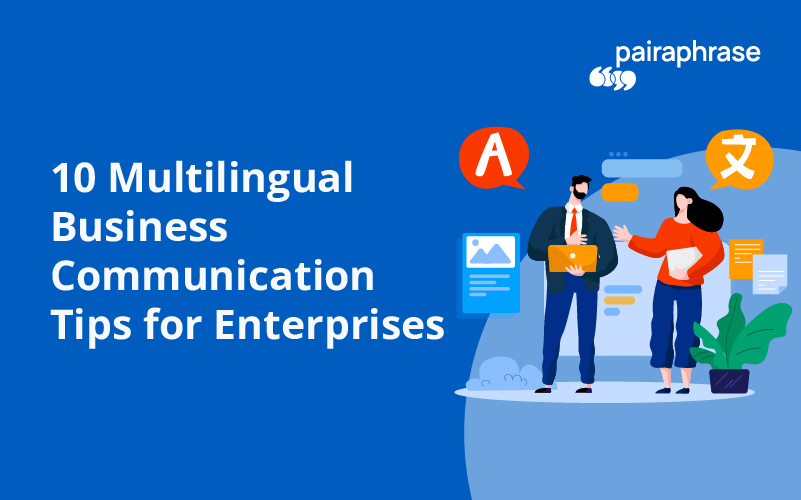Want multilingual business communication tips? We get it. Globalization is in full swing.
While there are more tools than ever to assist with international business expansion, it’s becoming increasingly competitive to expand to foreign markets. The one way you can position your brand for success is by creating a multilingual business communication strategy.
As language translation industry veterans, we’ve spent years working with enterprises on their multilingual written communications to compete in global markets. In this post, we share 10 tips with you, gathered from first-hand experience watching the most successful enterprises improve the way they communicate in the written form across languages and cultures.
10 Ways to Improve Multilingual Business Communication
1. Use Machine Translation for Gisting
At the end of the day, the bottom line speaks for successful written multilingual business communication. This means you are naturally going to look for ways to reduce costs and hours worked. To do so, start by using premium machine translation software built for multilingual business productivity. You will see drastic decreases in translation-related costs.
2. Choose Translation Software with Enterprise Security
Multilingual business communication calls for translation software with enterprise level security. This way, your organization benefits from the highest level of security and confidentiality.
You should be able to rest assured that none of your data is returned to any search engines nor shared with other users outside your organization. Look for state-of-the art encryption technology, multi-factor authentication and more to keep your data secure. This is an integral part of your risk management strategy.
3. Post-Edit for Machine Translation
This multilingual business communication tip goes hand-in-hand with tip #1. When you use pure machine translation, it essentially gives you rough “first drafts” for your multilingual corporate files. The translation is far from perfect (i.e. not ideal for important business matters or where the utmost professionalism is required).
In order to improve the quality, you (or a bilingual employee) needs to edit the machine-translated phrases. This process is called post-editing.
Since post-editing requires some resources, it’s smart to take proactive steps to reduce the amount of post-editing that’s needed. One way is to use machine translation software with dynamic machine learning. But we’ll get to that later.
4. Establish Document Publishing Standards
This multilingual business communication tip is a follow-up to #2. To make machine translation extra efficient, it helps to establish a set of guidelines to be used by all employees who originally produce or write the content for your documents. The publishing standards should address writing style, formatting, idiom use, sentence length and more.
5. Account for Culture in Multilingual Business Communication
This is one of the most overlooked tips for multilingual business communication.
Because translation is quite literal, pure translation isn’t always enough for important business dealings with foreign clients or customers. To truly connect with them, it’s important to understand the nuances of their culture. Consider customs, symbols and idioms and so on. This will give your company a competitive edge when it comes to international business.
6. Develop Separate Brand Guidelines
While your company might already have a brand book or messaging guidelines, you should create a separate book geared toward each non-English-speaking audience. This is because your brand should be adapted to the culture of each country you market to. This goes back to the culture aspect of multilingual business communication, covered in tip #4.
7. Prepare for Different Work & Management Styles
Working across cultures can be quite a shakeup for your employees, no matter how much travel experience they have. The same customs that apply to the business world in America can look drastically different once you work across countries and continents.
Oftentimes, social norms that apply in other cultures are also present while doing business. For some, this can have more shock value when encountered in professional situations than in personal situations. Prepare your employees and multilingual business communication processes for cross-cultural complexities, and you’ll be one step ahead.
8. Hire a Specialized Human Translator When Needed
Many enterprises cleverly use their existing resources (internal bilingual employees) to help with multilingual business communication. However, it’s important to know when to hire a specialized translator or interpreter. There are some circumstances that call for a specialized subject-matter translator.
For example, technical terminology, legal jargon and scientific concepts are best left to experts who are proficient in both the source language and target language.
9. Consider Using Technology in Place of an Interpreter
When you can’t hire an interpreter, use technology.
For example, use a secure app that translates text to speech and transcribes your conversations. This is going to be your ally in situations such as multilingual business negotiations or when working with an overseas team. Not only will it help align everyone in terms of what was discussed and agreed to, but it can also speed up your multilingual business conversations.
10. Develop a Termbase Glossary
Consistency is important when it comes to multilingual business communication.
Terminology management helps translation professionals maintain consistency in their communications and adhere to specific terms approved for use by their organization. A termbase glossary is a lifeline for enterprises that use specialized terminology and/or need to follow strict brand guidelines.
Many translation applications allow you to import glossary files in the form of TBX (Termbase eXchange) and look up terms while you edit machine translations.
11. Adopt a Translation Management System
Most of the multilingual business communication tips above are best implemented with a translation management system. Specifically, you should adopt a secure web-based system. This will help your company collaborate productively across teams without worrying about security breaches.
Recommended Translation Management System
At Pairaphrase, we developed the best all-around web-based translation management system available on the market today. This is because we’re hyper-focused on ease-of-use combined with the powerful technology you need to get smart, safe and fast translation. Pairaphrase enhances translation productivity and helps you achieve better translation quality.


.png)

.png)



